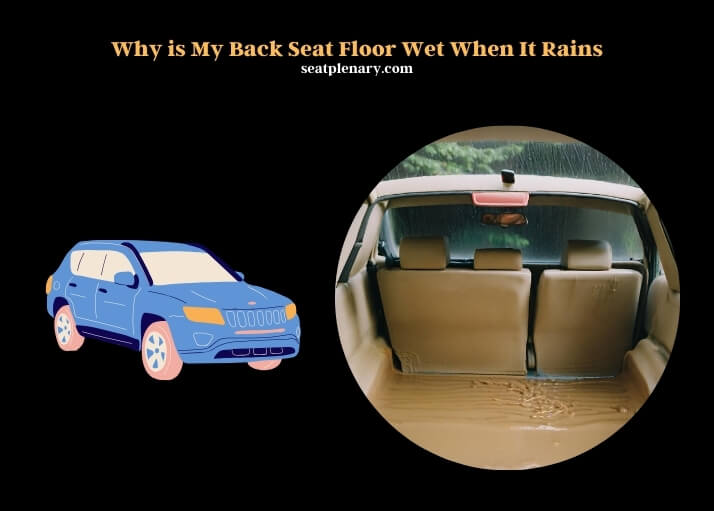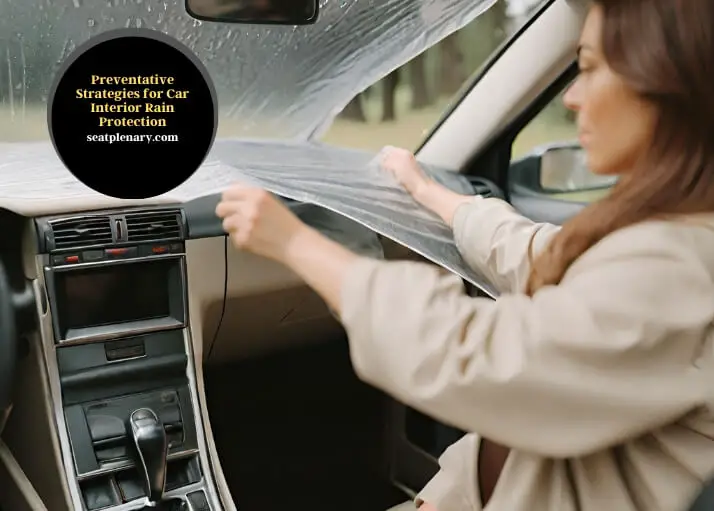Wet back seat floors during rain are often due to leaks in the vehicle’s weather sealing or drainage issues. Common culprits include worn door seals, clogged sunroof drains, and damaged window seals.
Vehicles are designed to keep water out, but over time, the barriers that prevent water ingress can fail. Door and window seals made of rubber can degrade, losing their elasticity and ability to keep water out. This is especially true for older vehicles where the materials have not only aged but have been exposed to the elements, leading to cracks and gaps.
Cars with sunroofs have drainage systems intended to channel water away from the interior. These drains can become blocked with debris, causing water to back up and find its way inside, often resulting in wet floors.
Air conditioning units can contribute to interior moisture if their drainage tubes are blocked, allowing water to leak inside the car rather than being expelled outside. Regular maintenance and checks of these systems are essential to prevent water from entering the vehicle. These issues promptly can help maintain the car’s interior, prevent mold growth, and ensure the comfort and safety of its occupants.

Root Causes of Car Water Leakage in Rain
Vehicle design flaws, worn seals, and blocked drainage systems are primary culprits for water seeping into cars during rain. Design flaws might include inadequate sealing around doors or windows, leading to water ingress. Over time, the seals and weather stripping around these areas can deteriorate, losing their effectiveness. This is especially true for older vehicles where the material may have become brittle or damaged.
Cars have built-in drainage systems to manage water flow, typically around the sunroof or air conditioning units. If these drainage paths are blocked, water can accumulate and find its way into the cabin, often pooling on the back seat floor. Regular inspection and maintenance of these components are crucial to prevent such issues.
Diagnosing Wet Car Floors Post-Rain
Identifying the source of leaks in a car requires a systematic approach. Start by inspecting the seals around doors and windows for any signs of wear or damage. Using water and observing how it flows around these areas can help pinpoint the exact location of a leak. Tools like hose pipes or water testing kits can be instrumental in this process.
It’s also essential to check the car’s drainage systems, particularly if it has a sunroof. Leaves and debris can often clog these channels, leading to water backup. A thorough inspection should include checking the undercarriage and wheel wells, as these areas can also be entry points for water.
Vehicle Health and Safety Concerns Due to Wet Floors
Wet floors in a vehicle are not just a nuisance but also pose significant health and safety risks. The primary concern is mold growth, which can develop in damp conditions, leading to health issues like allergies and respiratory problems.
Persistent moisture can cause corrosion and damage to the car’s interior, including the electrical system. This can lead to more severe problems, such as electrical failures or short circuits, posing safety hazards while driving. Regularly drying out the car and addressing any leaks immediately is vital to mitigate these risks.
Resolving Car Floor Wetness Effectively
Wet car floors involves both DIY fixes and professional solutions. Simple DIY methods include drying out the car thoroughly, using dehumidifiers, or applying sealants to minor leaks. For more severe issues, professional repair services are recommended. They can offer comprehensive solutions, including replacing weather stripping, repairing drainage systems, or even addressing structural flaws in the vehicle. It’s essential to choose a reliable service provider to ensure the problem is resolved effectively and prevent recurrence.
Preventative Strategies for Car Interior Rain Protection
Preventive measures are key to protecting car interiors from rain damage. Regular maintenance, such as inspecting seals and drainage systems, can prevent many issues. Weatherproofing strategies, like applying waterproof sealants or treatments to vulnerable areas, are also effective.
Using car covers or parking in sheltered areas can significantly reduce the risk of water ingress. It’s also beneficial to keep an eye on product recommendations for car care, as advancements in materials and technologies can offer better protection against water damage.

FAQs
Can Door Seals Cause Wet Car Floors?
Door seals, designed to keep water and air out, can fail over time. Exposure to elements and frequent use wear down these seals, leading to gaps through which rainwater can enter. This issue is particularly common in older vehicles where the rubber has become hard and brittle. Regular inspection and replacement of damaged seals can prevent water from leaking into the car, keeping the back seat floor dry during rain.
Is a Wet Back Seat Floor a Sign of a Leaking Roof in My Vehicle?
Discovering a wet back seat floor can be a sign of a leaking roof in your vehicle. Dealing with wet seats could indicate a problem with the roof seals or drainage system. It’s important to address this issue promptly to prevent further damage to your vehicle’s interior.
Is a Clogged Sunroof Drain Linked to Wet Floors?
Yes, a clogged sunroof drain can lead to wet car floors. Sunroofs have drainage channels that direct water away from the car interior. If these channels are blocked by debris, such as leaves or dirt, water can overflow and leak into the cabin, often pooling on the floor. Keeping these drains clean and clear of obstructions is crucial to prevent water from entering the vehicle.
How Does Air Conditioning Affect Interior Moisture?
Air conditioning systems can contribute to interior moisture in cars. The AC unit removes moisture from the air inside the vehicle, which is then supposed to drain outside. If the drainage tube is blocked or damaged, this water can accumulate and leak inside the car, often resulting in wet floors. Regular maintenance of the AC system, including checking and cleaning the drainage tube, is essential to avoid this problem.
Can Window Seals Prevent Rainwater Entry?
Window seals play a critical role in preventing rainwater from entering the car. These seals ensure that windows close tightly, leaving no space for water to seep through. Over time, these seals can wear out or become damaged, losing their effectiveness. Inspecting window seals regularly and addressing any signs of wear or damage promptly can help keep the car interior dry during rain.
Does Vehicle Age Influence Water Leakage?
The age of a vehicle can significantly influence its susceptibility to water leakage. Older cars may have worn-out seals, weatherstripping, and drainage systems that are not as effective at keeping water out as those in newer models. Components degrade over time, making it easier for water to find its way inside. Regular checks and maintenance are more critical for older vehicles to prevent water leakage.
Are Floor Plugs a Hidden Culprit Behind Wet Floors?
Floor plugs, designed to drain water from the car’s interior, can become a hidden culprit behind wet floors if they are missing or dislodged. These plugs can fall out or be removed during maintenance and not replaced, leaving open holes through which water can enter the vehicle, especially when driving through puddles or in heavy rain. Ensuring all floor plugs are securely in place and intact can help prevent unexpected water entry into the car’s interior.
In conclusion, understanding the causes, diagnosing, and addressing wet car floors due to rain is crucial for maintaining vehicle health and safety. Regular maintenance and preventive measures can significantly reduce the risk of such issues, ensuring a comfortable and safe driving experience.
